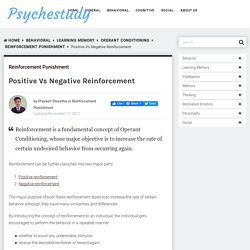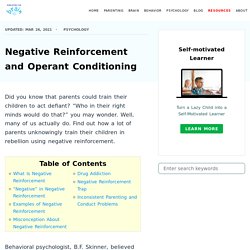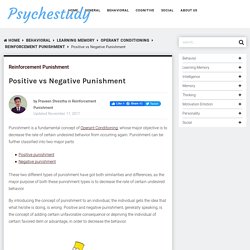

6.2 Operant Conditioning - YAS Psych Txtbk. Punishment, as you may have guessed, is when a behavior leads to a negative outcome.

If you receive a poor test grade because you did not study, then you are less like to not study again because you did not enjoy the punishment of a poor grade. Positive Vs Negative Reinforcement - Psychestudy. Reinforcement is a fundamental concept of Operant Conditioning, whose major objective is to increase the rate of certain undesired behavior from occurring again.

Reinforcement can be further classified into two major parts The major purpose of both these reinforcement types is to increase the rate of certain behavior although they have many similarities and differences. By introducing the concept of reinforcement to an individual, the individual gets encouraged to perform the behavior in a repeated manner whether to avoid any undesirable stimulusreceive the desirable reinforcer or reward again Differences Between Positive and Negative Reinforcement These examples are taken from the same scenarios; however, different reinforcers are made to interact with the individual. Positive Reinforcement and Examples - Psychology.
Positive reinforcement is a preferred disciplinary strategy in positive parenting because this method doesn’t involve aversive measures or punishment.

However, this method doesn’t always work the way we think. Negative Reinforcement and Operant Conditioning. Did you know that parents could train their children to act defiant?

“Who in their right minds would do that?” Positive vs Negative Punishment - Psychestudy. Punishment is a fundamental concept of Operant Conditioning, whose major objective is to decrease the rate of certain undesired behavior from occurring again.

Punishment can be further classified into two major parts These two different types of punishment have got both similarities and differences, as the major purpose of both these punishment types is to decrease the rate of certain undesired behavior. By introducing the concept of punishment to an individual, the individual gets the idea that what he/she is doing, is wrong. Positive and negative punishment, generally speaking, is the concept of adding certain unfavorable consequence or depriving the individual of certain favored item or advantage, in order to decrease the behavior. Positive Punishment in Operant Conditioning [Definition & Examples] Positive punishment is often used in life when we want to suppress unwanted behavior.
![Positive Punishment in Operant Conditioning [Definition & Examples]](http://cdn.pearltrees.com/s/pic/th/punishment-conditioning-239609851)
Let’s examine its definition, usage and examples, especially when it comes to parenting. What is Positive Punishment Positive punishment is a type of operant conditioning, a theory proposed by psychologist B.F Skinner. Its main purpose is to reduce the likelihood of an undesired behavior repeating in the future by applying an aversive stimulus after the behavior occurs. What is Negative Punishment (Examples and Effectiveness) In this article, we will review negative punishment, its definition, examples, and drawbacks.

American psychologist B.F. Skinner developed the theory of operant conditioning, which stated that a person or animal’s behavior could be increased or decreased by adding or removing appropriate stimuli after the behavior is exhibited. The difference between classical conditioning and operant conditioning is that classical affects unconscious behavior, while operant affects conscious behavior. Learning: Negative Reinforcement vs. Punishment.
12 Examples of Positive Punishment & Negative Reinforcement. You might be thinking that “positive punishment” sounds like an oxymoron, after all, how can punishment be positive?

Not many people “like” punishment, right? The disconnect in understanding this concept comes from the usage of the word “positive;” here at PositivePsychology.com, we generally use the term “positive” to refer to things that are inherently good, things that are life-giving, and things that promote thriving and flourishing. The concept of positive punishment comes from a very different era and a very different perspective on psychology; namely, the 1930s and behaviorism.
So, what actually is positive punishment and how does it relate to parenting, teaching, and even the workplace? Before you read on, we thought you might like to download our 3 Positive Psychology Exercises for free. You can download the free PDF here. Reinforcement or Punishment by Behaviorbabe. Adolescent learning: rewards, punishments, and the importance of context.
Adolescents’ unique sensitivity to rewards is thought to be due to increased activity in and communication between areas of the brain that respond to rewards.

However, we also know that many of the same brain areas also respond to punishment and that there are dynamic changes occurring throughout the brain during adolescence. Much like the complexity of brain development, the story about how adolescents learn from reinforcement might not be so simple. “The way that adolescents learn from the choices that they have made in the past will ultimately influence their future choices and actions.”
An in-depth review of studies examining how we learn from reinforcement across age shows mixed results. Contrary to the idea that adolescents may learn best from rewards, some studies find that adolescents actually learn more from punishment. The context in which learning takes place may be key. Studies conducted to date have subtly varied the learning context in different, specific ways. Teenagers: 20 tips for good behaviour. 1.

Take time to actively listen Actively listening means paying close attention to what your child is saying and feeling, rather than thinking of what you want to say next. This shows your child that you care and that you’re interested. 2. Set clear rules about behaviour Family rules make expectations about behaviour clear. If you can, involve all family members in the discussions about rules. 3. You can read more about setting boundaries and using consequences in our article on discipline strategies for teenagers. 4.
Follow up by asking your child what a fair consequence would be if it happens again. Disciplining Your ‘Tween And Teens Using “Inductive Discipline” – NewsNet.